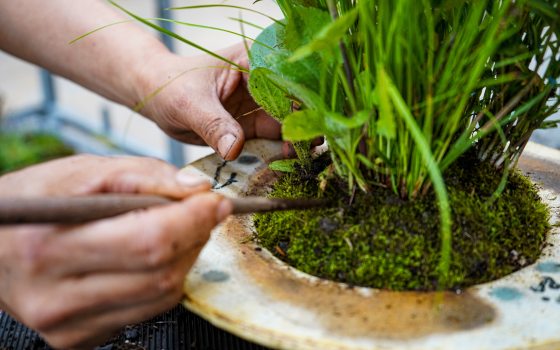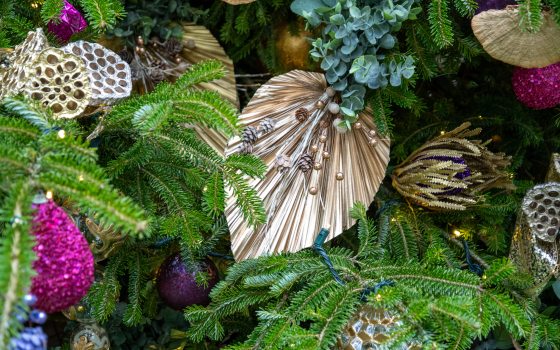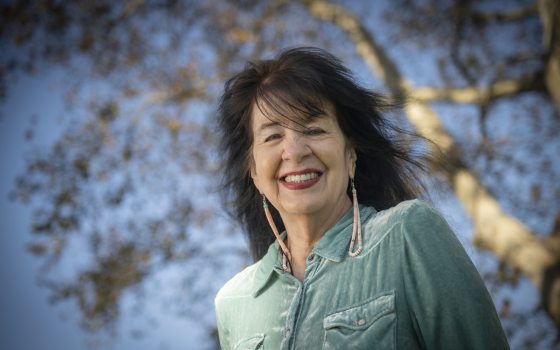With its name composed of two Japanese characters that mean “grass” and “thing”, the literal translation of kusamono—a Japanese botanical art of small, potted grasses traditionally displayed next to bonsai as seasonal accent plants—may suggest that this Japanese botanical art is unassuming or falls secondary to its bonsai counterpart. After even just a few minutes spent watching renowned kusamono artist Young Choe work, however, it’s glaringly obvious that nothing could be farther than the truth. Much like her gift of translating humble, everyday plants into literal works of art, Choe also has a gift in being able to demonstrate just why kusamono has recently developed into an artform of its own. Choe has also recently shared another gift with Longwood—in the form of dozens of her kusamono—including some she recently created here— which are now part of Longwood’s growing bonsai collection, and will be displayed in the new Bonsai Courtyard upon its opening as part of Longwood Reimagined: A New Garden Experience.
In its simplest definition, kusamono are potted arrangements of wild grasses and flowers—either single plants or groups of plants—chosen and placed in unique pots or trays to suggest a season or place. Kusamono, however, are anything but simple. A well-chosen and well-composed kusamono reflects a specific natural habitat—from wetland to meadow, woodland to aquatic—as well as reflects the season, or multitude of seasons, in which it is displayed. For Choe, when choosing plants for kusamono, she looks “towards nature and plants that interact in their own ecosystem. For example, American wintergreen (Gaultheria procumbens), partridgeberry (Mitchella repens), Pennsylvania sedge (Carex pensylvanica), and lowbush blueberry (Vaccinium angustifolium) grow together in the same habitat.”
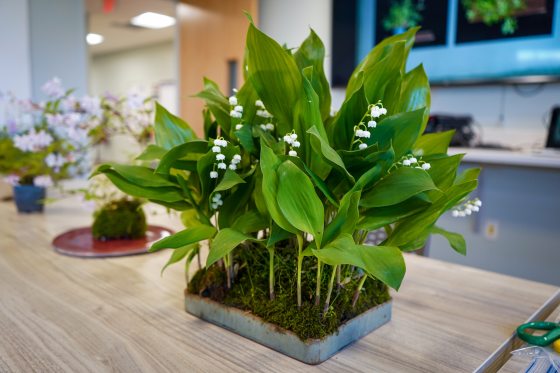
Among Young Choe’s kusamono given to Longwood is this elegant lily-of-the-valley. Photo by Carol Gross.
When she approaches her kusamono, Choe is “always thinking about all four seasons, so they have a different character with each season and each year. The plants can go through cycles of dormancy and rebirth annually and can live for more than 10 years with proper care.” Astoundingly, Choe avoids repotting her kusamono unless it’s absolutely necessary—meaning that when she creates each kusamono, she’s creating with a vision of what that kusamono will look like—and how it will grow— throughout each season, a decade ahead.
Choe views kusamono as a combination of horticulture and art, in which the maker needs not only an artistic sense, but also vast knowledge of the plants with which he or she is working, including the plants’ habitats, growth forms, root systems, preferred sunlight exposure, flower color, bloom time, and leaf shape. When Choe first became interested in kusamono decades ago however, she didn’t know anything about bonsai—or gardening in general—at all. Choe had studied traditional art in her native Korea before moving to the United States. When she decided to volunteer at the U.S. National Arboretum in Washington DC nearly 25 years ago, Choe found herself placed in the arboretum’s National Bonsai and Penjing Museum—and then found herself fascinated by the accent plants of bonsai.
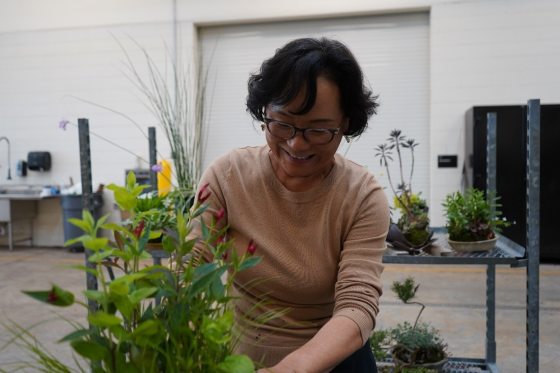
Young Choe works on a new kusamono—this one featuring such plants as pink-root (Spigelia marilandica ‘Little Redhead’) while conducting staff and volunteer training at Longwood in early May. Photo by Carol Gross.
Her volunteer work inspired her to go back to school and earn her degree in horticulture from the University of Maryland and her interest in kusamono led her to learn Japanese and then travel to Japan to study the artform firsthand with master kusamono artist Keiko Yamane. Upon her return to the US, Choe worked for many years with the US Department of Agriculture as a seed specialist and continued her volunteer work with the National Bonsai and Penjing Museum.
Choe views her journey to becoming a kusamono artist as unique as the artform herself. “The unique part of creating kusamono is using humble wildflowers, grasses, and what others refer to as ‘weeds’ to create an artform that shows the beauty of plants through the seasons,” shares Choe. “I love all plants, but am more interested in using native plants, as well as small, not showy, selections. While I prefer native plants, I can use pretty much anything, but I try to avoid annuals because of their brief lifespan, other than sometimes using them for a short-term piece.”
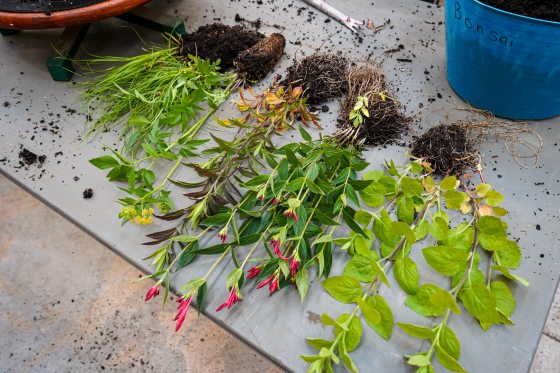
A variety of plants, including pink-root (Spigelia marilandica ‘Little Redhead’), rough goldenrod (Solidago rugosa ‘Fireworks’), goldenrod (Solidago sphacelata ‘Golden Fleece’), Pennsylvania sedge (Carex pensylvanica), and golden alexanders (Zizia aurea) await during Choe’s kusamono training. Photo by Carol Gross.
Beyond creating a kusamono itself, it takes much foresight and much consideration in knowing what kind of kusamono to create in relation to the bonsai it will be paired with. One must identify the bonsai species, examine the environment of that species, research plants in that environment that will do well in kusamono, and then explore potential pots or containers to harmonize it all.
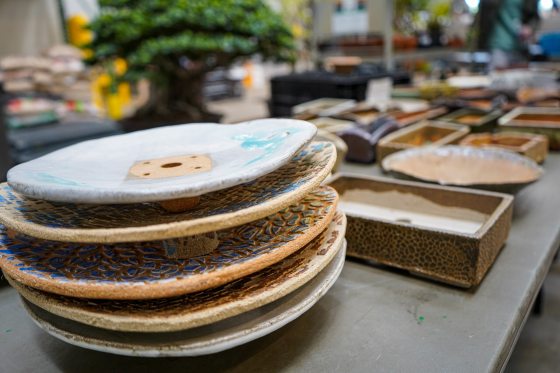
To Young, in kusamono, “the plants and containers talk to one another.” Photo by Carol Gross.
Choe finds her inspiration in nature, often hiking as she travels throughout the world to conduct kusamono workshops and lectures. “When I’m hiking, I always take the time to look in that natural habitat to see what plants are growing and how they’re growing.” At home, she maintains her own kusamono garden—in addition to the hundreds of kusamono she has crafted by propagating plants, from collecting plants from the wild, from growing plants, or through purchasing plants—as well as collects roof tiles and containers in which to place them. “My relationship with kusamono is almost as if they’re my children,” shares Choe. “I need to truly know each of them to best care for them and tell their stories. It requires a lot of patience and it's a lot of hard work. It’s like a swan on a lake. On the surface, kusamono look beautiful and elegant, but under the water, that swan is constantly paddling.”
Most of Choe’s kusamono collection is assembled in her home and garden. “Because I know how much work it takes to maintain a kusamono,” Choe reflects,” I rarely sell them.” Longwood, however, is honored to have recently acquired a selection of dozens of kusamono from Choe—some of which she crafted here at Longwood, alongside Bonsai Curator Kevin Bielicki, as well as a number of volunteers who help care for Longwood’s bonsai collection. When choosing plants for the workshop, Choe selected those to “provide a good learning experience and produce a happy community of plants in a pot.”
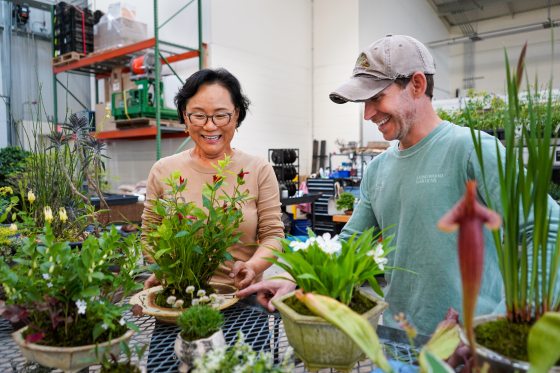
Young Choe and Longwood Bonsai Curator Kevin Bielicki observe some of the newly crafted kusamono in Longwood’s nursery production greenhouse. Photo by Carol Gross.
Choe spent two days at Longwood in early May to share her craft and conduct a hands-on workshop for this team on how to create and maintain kusamono. The results of which—which will be put on full display upon the opening of the new Bonsai Courtyard as part of Longwood Reimagined: A New Garden Experience—are simply beautiful.
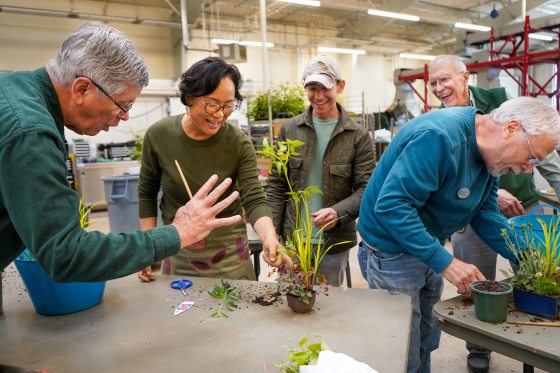
From left, Volunteer Steven Ittel, Young Choe, Bonsai Curator Kevin Bielicki, Volunteer Bill Mitchell, and Volunteer Bill Cushing, practice the steps of kusamono during a Choe’s training session. Photo by Carol Gross.
Showcasing these kusamono in the new Bonsai Courtyard help elevate the display of our renowned bonsai collection, as well as help emphasize the trees’ aesthetic shifts throughout the seasons. Choe’s time spent at Longwood creating and teaching kusamono—as well as the many times she’ll return to Longwood to see them again firsthand—also helps elevate the artform of kusamono itself, sharing its technique with those who seek to perpetuate the artform, as well as sharing its beauty—and story—with many, many more. “Above all, I seek to share happiness with kusamono,” shares Choe. “That’s really what it’s all about.”
